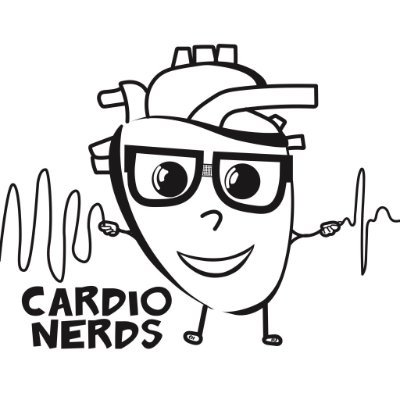
Zaid Safiullah, MD
@zsmd92
Followers
82
Following
9
Media
2
Statuses
49
NIH Critical Care Fellow @OslerResidency @PittMed alum passionate about med ed, critical care cardiology and basic science
Joined October 2021
A new era of #HF therapeutics❗️ Steroidal MRA: #SPIRRIT #SPIRITHF Nonsteroidal MRA: #FINEARTS MR modulator: #BalanceD GLP1RA: #STEPHFpEF GIP/GLP1: #SUMMIT ARNI: #PARAGLIDE IL6i: #HERMES MPOi: #ENDEAVOR sGC stimulator: #VICTOR Digoxin: #DIGITHF #DECISION IV Fe: #HEARTFiD #FAIRHF2
HERMES Investigator Meeting in Baveno, Italy Will IL-6 inhibition with ziltivekimab improve outcome in #HFpEF? We will find out in a 2027. 👥Target n=5600 🌍46 countries https://t.co/YyLYjkfGuZ
0
51
185
So many great pearls!
ICYMI 🚨 @penncardiology fellows @meganfburke & @yoavkarpenshif appeared on @cardionerds'🎙️recent episode on biventricular failure & the use of VA-ECMO. Listen here 👉 https://t.co/2dfrpslCCU
@penncvfellows
0
0
0
What an invaluable experience to take a deep dive in content creation in cardiology MedEd! As an academy fellow, I especially enjoyed creating dynamic tweetorials and learning from the experts during journal clubs 💯
🚨ATTN CardioNerds! Applications are open for the CardioNerds Academy! If you are a current trainee interested in the intersection of medical education & #SoMe, we encourage you to apply! 📜Applications EXTENDED to November 20th! 🔗 https://t.co/7BbgLbopLE
0
2
7
So excited to explore the use of #tirzepatide in the reduction of obesity! A 🔑 to preventing #ASCVD 🫀
🔛HAPPENING TOMORROW! 9/7 @7P EST #HouseJones @CardioNerdsJC #CardsJC present... An AMAZING discussion about the 🧗SURMOUNT-1 Trial with our leading experts! #Tirzepatide See you there❣️ @DrAlaaDiab @BreannaHansen_ @AG_Kalluri @zsmd92 @CFAndersenMD @CardioAtHeart @tygluckman
0
1
6
A huge congratulations to two of my mentors!
RESULTS ARE IN: the HFC and @HFSA are proud to name @AmitGoyalMD and @Dr_DanMD TOP Principal Investigators of 2022!! @CardioNerds @ClevelandClinic @hopkinsheart DON'T MISS the HF Research Update: Conducting HF Trials in the U.S @ #HFSA2022! Awardees: https://t.co/s4yFoALpmP
0
0
0
19/ 3. Extremis, impending circulatory collapse despite maximal pharmacological and mechanical support. Rounds of CPR, defibrillations, and bolus doses of vasopressors may also be seen at this stage.
1
2
6
18/ 2. Classic, There is evidence of organ ischemia. Hypotension is often observed but not necessary for cardiogenic shock. In classic shock, organ hypoperfusion is refractory to fluid resuscitation and requires pharmacological or mechanical intervention.
1
3
5
17/ Answers and Explanations: 1. Beginning, there is evidence of hemodynamic instability, namely tachycardia and soft pressures). He does not strictly speaking have any evidence though of organ hypoperfusion, therefore he is in the beginning stages of shock.
1
3
5
16/ There are currently efforts to further define the SCAI stages with specific parameters that underlie hypoperfusion, hypotension and treatment strategy, one proposed model is from Kapur et. al PMID 35835491 This is an area of further exploration and poses a challenge!
1
3
8
15/ Understanding and applying the SCAI shock stages at bedside aids in the risk stratification for patients who may be at risk for CS. It allows clinicians to communicate the extent of CS in a standardized way, this is crucial in the multiD treatment of shock by a shock team.
1
3
3
14/ 3. 62-year-old s/p acute LAD STEMI with worsening CS despite 2.5 of norepi and 0.04 of vasopressin and Impella at P9. He is comatose with lactose >8 with pH of 7.1, now requiring bolus doses of vasopressors
1
3
3
13/ 2. 55-year-old s/p acute LAD STEMI, with BP 85/60 HR 124, with oliguria, worsening AKI, AST 967/ALT 624, lactate 3.4, cardiac index 1.7, PCWP 20 CVP 15, s/p 2.5L fluid and now started on norepi what is his SCAI Shock stage?
1
3
3
12/ Now for some questions! 1. 72-year-old s/p acute LAD STEMI, with BP 90/62, HR 110 elevated JVP, normal lactate, cardiac index 2.7, PCWP 12 CVP 8, what is his SCAI Shock stage?
1
2
4
11/ Differentiating stage C from D can also be tricky: the key here is no longer to focus on how deranged lactate/hemos are, but instead focus on response to initial therapy. If initial vasoactive/MCS therapy is ineffective, then stage D is present, and you may be crashing to E.
1
3
6
10/ Differentiating between stage B and Stage C can be difficult, Stage C is characterized by hypoperfusion. Stage B perfusion is preserved. Therefore, one MUST go to the bedside! And examine with an eye for organ malperfusion!!!
1
3
5
9/ Stage E = Extremis which is essentially actual or impending circulatory collapse☠️, near pulseless, or profound hypotension despite max hemodynamic support, at this stage there is frank evidence of refractory hypoperfusion with lactate > 8, pH< 7.2. Mortality approaches ***%
1
3
5
8/ Stage D = Deteriorating shock. Despite the initial management strategy, ESCALATION of vasopressors or mechanical support is necessary. This stage is an emergency🚑to avoid Stage E.
1
3
5
7/ Stage C = Classic Shock⚡️. Hypoperfusion (lactate elevation, AKI, Increasing LFTs, decreased cardiac index and increased PCWP) with or without hemodynamic instability. Vasopressors💉or mechanical support are required to overcome derangements.
1
3
5
6/ Stage B = Beginning shock⚡️, a patient w/ hemodynamic instability (hypotension, tachycardia, or abnormal systemic hemodynamics) WITHOUT hypoperfusion. The key here is to frequently monitor for any sign of malperfusion (cool extremities, drop in UOP, AMS, lactate >2)!
1
3
5




